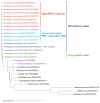Monkeypox: A New Threat?
- PMID: 35887214
- PMCID: PMC9321130
- DOI: 10.3390/ijms23147866
Monkeypox: A New Threat?
Abstract
The global vaccination programme against smallpox led to its successful eradication and averted millions of deaths. Monkeypox virus (MPXV) is a close relative of the Variola (smallpox) virus. Due to antigenic similarity, smallpox vaccines cross-protect against MPXV. However, over 70% of people living today were never vaccinated against smallpox. Symptoms of monkeypox (MPX) include fever, head- and muscle ache, lymphadenopathy and a characteristic rash that develops into papules, vesicles and pustules which eventually scab over and heal. MPX is less often fatal (case fatality rates range from <1% to up to 11%) than smallpox (up to 30%). MPXV is endemic in sub-Saharan Africa, infecting wild animals and causing zoonotic outbreaks. Exotic animal trade and international travel, combined with the increasing susceptibility of the human population due to halted vaccination, facilitated the spread of MPXV to new areas. The ongoing outbreak, with >10,000 cases in >50 countries between May and July 2022, shows that MPXV can significantly spread between people and may thus become a serious threat to public health with global consequences. Here, we summarize the current knowledge about this re-emerging virus, discuss available strategies to limit its spread and pathogenicity and evaluate its risk to the human population.
Keywords: 2022 MPXV outbreak; MPXV; emerging viruses; monkeypox; zoonosis.
Conflict of interest statement
The authors declare no conflict of interest. The funders had no role in the design of the study; in the collection, analyses, or interpretation of data; in the writing of the manuscript; or in the decision to publish the results.
Figures




References
-
- Von Andersen E.K.P.M., Petersen K.B., Birch-Andersen A. A Pox-Like Disease in Cynomolgus Monkeys. Acta Pathol. Microbiol. Scand. 1959;46:156–176.
-
- Multi-Country Monkeypox Outbreak: Situation Update. [(accessed on 1 July 2022)]. Available online: https://www.who.int/emergencies/disease-outbreak-news/item/2022-DON396.
Publication types
MeSH terms
Grants and funding
LinkOut - more resources
Full Text Sources
Medical

